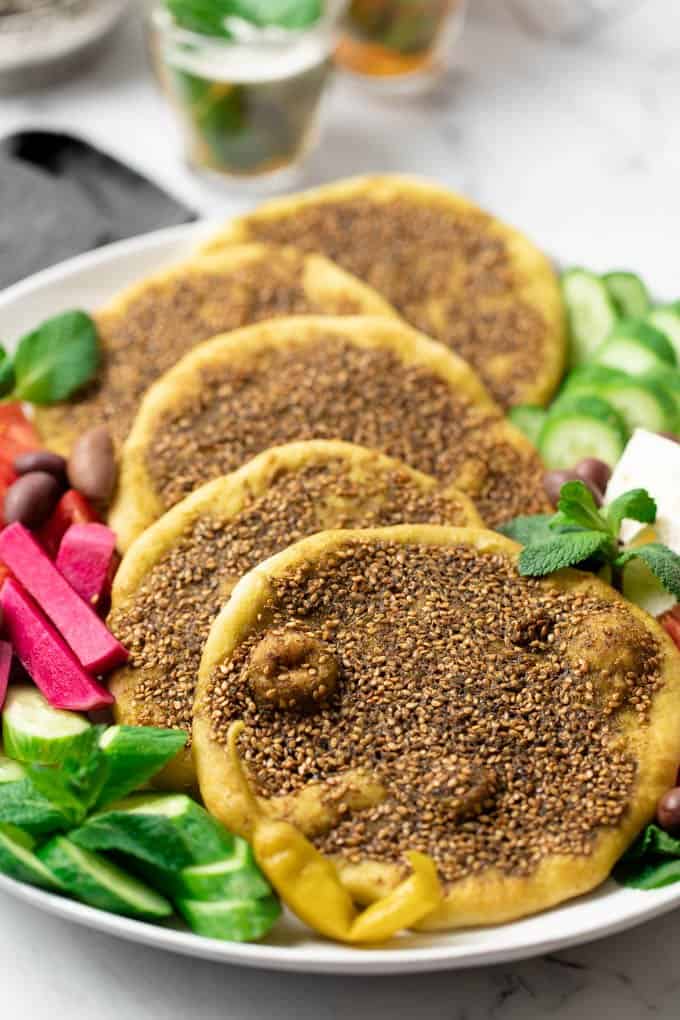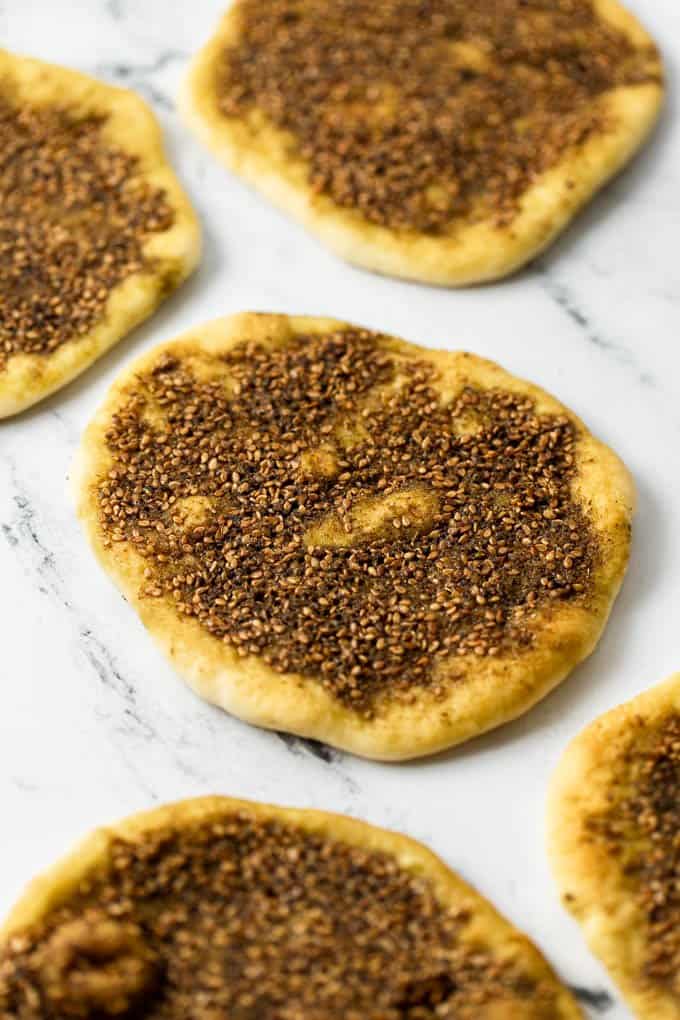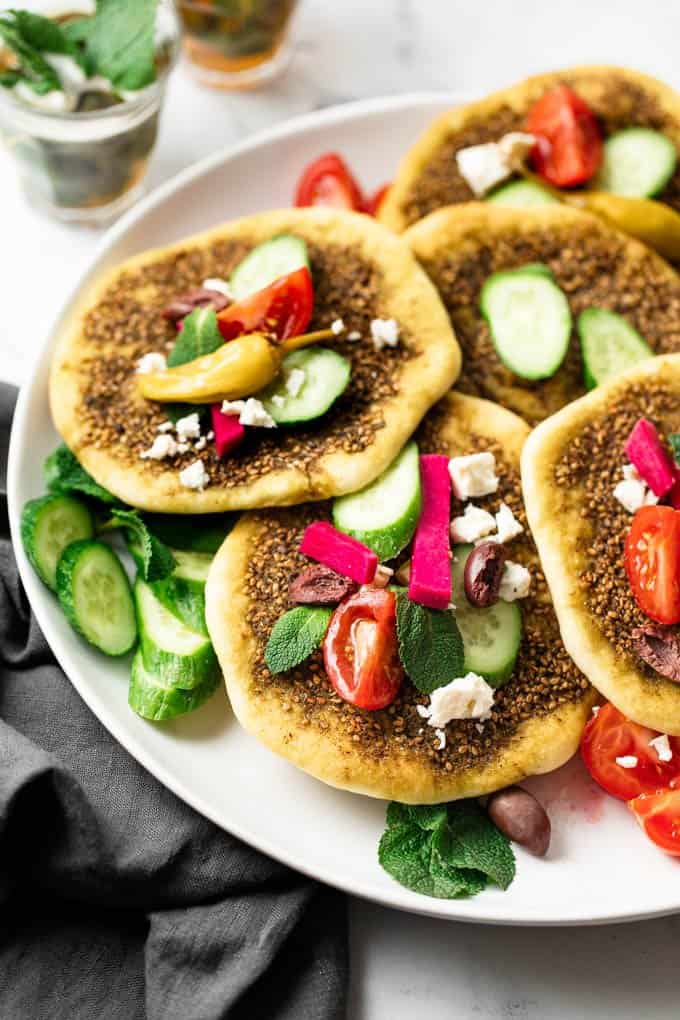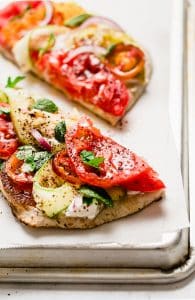Za'atar Manakish, the Levant's (Eastern Mediterranean) signature sandwich! The Za'atar Manakish is a flatbread adorned with the za'atar spice blend and olive oil. It's a very simple recipe that only uses a few pantry ingredients. It's so delicious, once you make it you'll understand why it's so loved by young and old.

Za'atar Manakish
If you've ever been to a Middle Eastern Bakery, the humble za'atar manakish is front and centre and it's also the cheapest of the manakish at the Middle Eastern bakeries. The most popular manakish is the zaatar, but most people who aren't familiar with the za'atar manakish just glance over this delightful manakish for the more popular versions.
Za'atar manakish isn't just popular to purchase from the bakery is also very common to find being made in the homes of the local people of the eastern Mediterranean. It's more common to see the locals dipping fresh bread into olive oil and za'atar spice blend during breakfast than seeing the manakish, however, the za'atar manakish is a part of a weekly rotation in most homes.

What is Manakish?
Manakish (also known as manakeesh, manaeesh, manaqish, man'oushe and fatyer) is a Levantine flatbread that is often served for breakfast with fresh vegetables, herbs and tea. Sometimes it's also served as a snack or for lunch.
There are 3 popular types of manakish: za'atar manakish, cheese manakish and meat manakish (also known as Lahmacun). However, there are so many variations of manakish and they're just as delicious as this famous trio.
They're are all made the same dough recipe but with different toppings. The dough used for manakish is the same as pizza dough actually I use the same dough for both recipes. The main difference is you make smaller round pieces of pies then add the toppings. Think of the manakish as a personal-sized pizza, that can be topped with fresh veggies and folded up like a sandwich.
What is Za'atar?
Za'atar (pronounced ZAah' tar) is an Eastern Mediterranean herbal blend of wild Mediterranean thyme (hyssop), sumac, and toasted sesame seeds. The wild thyme is native to the Eastern Mediterranean countries, Palestine, Lebanon, Syria, Turkey and Greece. The plant is very similar to oregano in looks and smell, but the taste is like a combination of thyme and oregano. That's why many recipes will recommend you to mix the two herbs.
Since Za'atar is often bought as a spice blend and not as a herb, you'll be able to find many different types of za'atar blends. Each spice shop and or region has their own recipes that can and do add many other herbs such as marjoram and thyme. Some suppliers add wheat as a filler to spice mixture to keep the cost down, so keep in mind that many za'atar blends are not gluten-free. Others use citric acid to reduce the amount of sumac well still providing a citric flavour profile. There are no standards or regulatory bodies to protect the quality of za'atar your buying, So it's VERY IMPORTANT TO READ THE LABELS or know your suppliers.
However, do let this stop you from trying to seek the best Za'atar you can find. Not only is this spice mix tasty, it offers some pretty amazing side effect too!
Here are 5 reason you need Za'atar on your table:
- Rich in antioxidants
- Helps Clear Respiratory Tracts (Great for colds)
- Boost Cognition by boosting memory
- Soothes and helps reduce Inflammation
- Improves Mood
How do you select the best za'atar blend?
A good quality za'atar blend should have bold aromatic herby and subtle citrus undertones, and just a hint of nuttiness from the sesame seeds.
- Very fragrant.
- Toasted sesame. Seeds must be toasted.
- Ground sumac will be a part of the blend. How much of it depends on the variations.
You may notice that sometimes the za'atar is greener and other time is redder. This doesn't mean your za'atar isn't good. There are two main types of za'atar regardless of how many variations of this spice blend there is.
Green Za'atar: This za'atar is bright green from the za'atar in the spice blend, has less sumac, and most of the time doesn't have wheat fillers. When mixing this za'atar with olive oil, you'll notice more of a greenish hue.
Red Za'atar: The taste is good, the red colour comes from the sumac, and it has a bit more of a tart flavour. When mixing this za'atar with olive oil, you'll notice more of a reddish-brown hue which is fine.
What You'll need to make Za'atar Manakish
Making this classic manakish is so simple you only need 3 things!
- Za'atar
- Olive oil
- Dough Recipe

How to Make Your Manakish!
- Make your dough. Use my ultimate dough recipe!
- Prepare the topping. Mix together the olive oil and za'atar, then set aside until ready to assemble.
- Shape the manakish. Divide the dough into 12 balls (45g). Roll the dough into a circle (just like pizza)
- Pile on the topping. Scoop two tablespoons of za'atar mixture onto the dough.
- Bake! Transfer to the oven and bake for 7-10 minutes.
- EAT! This is the best part! Don't forget to share with a friend.
How to serve the Za'atar Manakish?
How to set up a traditional Eastern Mediterranean breakfast⏤set your table with the manakish and fresh cheeses of your choice; even traditional Labneh is welcomed. Typically, you'll also find manakish served with lots of fresh vegetables like cucumbers, tomatoes, green onions, radishes, olives, and tea.

Storage and freezer instructions
Fridge: Place the manakish into an airtight container. Refrigerate for 4-5 days.
Freeze: Place a small piece of parchment paper between the manakish and place them into an airtight container or a freezer bag and freeze them for up to 3 months.
Reheat: Warm up the manakish in the oven (or microwave) before serving again or thaw them in the oven and enjoy!
IF YOU LOVE MEDITERRANEAN RECIPES, subscribe to my newsletter and follow along on Facebook, Pinterest and Instagram for the latest updates and recipes.
Za'atar Manakish

Za'atar Manakish, the Levant's (Eastern Mediterranean) signature sandwich! The Za'atar Manakish is a flatbread adorned with the za'atar spice blend and olive oil.
Ingredients
- ¼ cup za'atar spice blend
- ¼ cup olive oil
- ½ teaspoon salt
- ½ Ultimate Dough Recipe
Instructions
- Prepare the Dough recipe as directed.
- Preheat oven to 375ºF and line to 9x13 baking sheets with parchment paper. Set aside.
- Separate the dough into 12 (54g) balls, then roll the balls, cover with a clean towel and let rest for 10 minutes.
- Mix together the za'atar, olive oil and salt in a bowl and set aside.
- Once the dough had rested, then roll into thin circles. They should be about 10" in size.
- Transfer the dough rounds to a parchment-lined baking sheet. You will need to use 2 baking sheets to fit them all or wait for some to bake then add the rest.
- Place the za'atar mixture on the dough and make sure to cover the entire surface, leaving a ¼ inch border.
- Place the baking sheets in the oven on the bottom rack and bake for 12-15 minutes until the bottom is lightly golden.
- Remove baked manakish and place in a platter and cover with a towel or plastic bag to keep them soft until serving
Recommended Products
As an Amazon Associate and member of other affiliate programs, I earn from qualifying purchases.
Nutrition Information:
Yield:
6Serving Size:
1Amount Per Serving: Calories: 274Total Fat: 14gSaturated Fat: 3gTrans Fat: 0gUnsaturated Fat: 11gCholesterol: 0mgSodium: 389mgCarbohydrates: 11gFiber: 1gSugar: 0gProtein: 1g









Jessie
I can say I have never had this before but it does sound good. I will be making a trip to the city market soon to see if I can find the za'atar spice blend
Sarah
I hope you find a great za'atar blend and enjoy these tasty pies!
Brianna
I love za'atar this looks delicious!
Caitlyn Erhardt
Yum! I had never tried something like this, so wasn't sure what to think. It wound up being very tasty and my kids liked it as well.
Sarah
I'm so glad to hear your family loved it!
Patrice
I love za'atar! Thanks for all the great tips and background info. Your recipe looks delicious.
Sarah
Thank you!